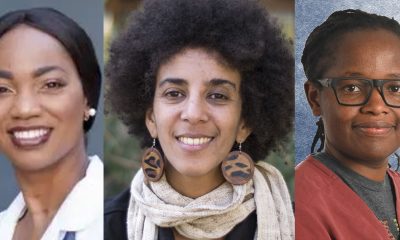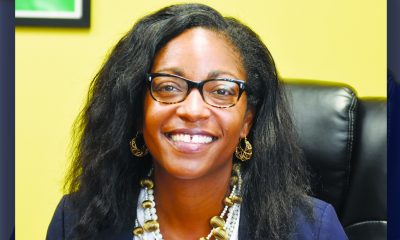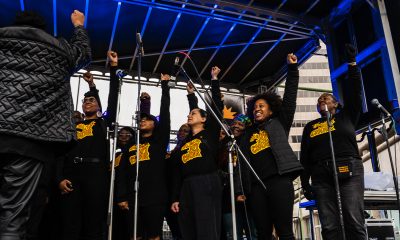Education
Urban Releaf Grows Green Jobs and Shade Trees
When director Kemba Shakur started an urban forestry nonprofit organization 15 years ago, the goal was to address the ecological needs of the community, which was in desperate need of more trees and greenery.
She remembers that when she moved to Oakland in 1994, 57th Street didn’t have a single tree.
Now, the block boasts over 30 trees and counting. The success of Shakur’s Urban Releaf has expanded beyond her neighborhood to the rest of Oakland, leading to 16,000 trees planted and maintained.
The organization’s tree planting efforts contribute to improving air quality and increasing environmental awareness in the Bay Area.
“We believe that communities can be transformed through trees because urban forestry is an area where we can increase green jobs by training and hiring young Black men be successful arborists [persons that focus on the health and safety of trees],” said Shakur. “Currently, there are five Black arborists in California; four of them work on our staff.”
Shakur has received several awards including the 2013 J. Sterling Morton Arbor Day Award from the Arbor Day Foundation as well as being named as one of 2013 Barefoot “Soles of the Year” by Barefoot Wine, a Bay Area winery.
She says she hopes to encourage the city to have a tree canopy of 40 percent, a goal required by the EPA’s greenhouse gas (GHG) emissions reduction program. Currently, Oakland’s tree canopy is well below that at only 12 percent. The benefits of a larger tree canopy include increased health benefits such as a reduction of particulate matter from entering the Bay, as well as providing bird and insect sanctuaries.
Urban Releaf has launched numerous programs that focus on environmental training of low-income youth, working with other community organizations like Berkeley Youth Alternatives to coordinate projects involving tree planting, long term care, maintenance, and monitoring in public spaces throughout the city.
Program Manager Kevin Jefferson III says he is always seeking clever ways to repurpose wood so it can help out the community.
“Newly planted trees need to be stabilized with stakes for at least two years,” said Jefferson. “Normally, the stakes get thrown into a landfill, which we would have to pay Berkeley Waste Management for. Now, we’re recycling and using everything from tree stumps and stakes to old mattress frames and palettes.”
The recycled pieces of woods are cut down and fashioned into chairs, desks, fences, and other items of furniture.
With private funding for Urban Releaf ending in October, Shakur says the organization is looking for new investors and will be working closely with the Oakland Museum of California to sell many of these products at the museum store.
The group has worked with UC Davis and UC Berkeley to highlight scientific research on the benefits of urban forestry and how they improve air quality, provide shelter for wildlife, and reduce home energy and water costs.
Kwame Davis started working for Urban Releaf in his early teens and is close to obtaining his International Society of Arboriculture Certification. He also plans to study marine biology.
“Generally, we’ve had a good response from neighborhoods when we come in to plant in front of their houses,” said Davis, an Urban Forest Mentor. “Some people even try to contribute and pickup a shovel to help dig. That shows that they take pride in their community.”
There will be a membership drive at the on Oct. 4 at the Oakland Museum to raise money for Urban Releaf.
Activism
OPINION: Supreme Court Case Highlights Clash Between Parental Rights and Progressive Indoctrination
At the center of this controversy are some parents from Montgomery County in Maryland, who assert a fundamental principle: the right to shield their children from exposure to sexual content that is inappropriate for their age, while also steering their moral and ethical upbringing in alignment with their faith. The local school board decided to introduce a curriculum that includes LGBTQ+ themes — often embracing controversial discussions of human sexuality and gender identity.

By Craig J. DeLuz, Special to California Black Media Partners
In America’s schools, the tension between parental rights and learning curricula has created a contentious battlefield.
In this debate, it is essential to recognize that parents are, first and foremost, their children’s primary educators. When they send their children to school — public or private — they do not surrender their rights or responsibilities. Yet, the education establishment has been increasingly encroaching on this vital paradigm.
A case recently argued before the Supreme Court regarding Maryland parents’ rights to opt out of lessons that infringe upon their religious beliefs epitomizes this growing conflict. This case, Mahmoud v. Taylor, is not simply about retreating from progressive educational mandates. It is fundamentally a defense of First Amendment rights, a defense of parents’ rights to be parents.
At the center of this controversy are some parents from Montgomery County in Maryland, who assert a fundamental principle: the right to shield their children from exposure to sexual content that is inappropriate for their age, while also steering their moral and ethical upbringing in alignment with their faith. The local school board decided to introduce a curriculum that includes LGBTQ+ themes, often embracing controversial discussions of human sexuality and gender identity. The parents argue that the subject matter is age-inappropriate, and the school board does not give parents the option to withdraw their children when those lessons are taught.
This case raises profound questions about the role of public education in a democratic society. In their fervent quest for inclusivity, some educators seem to have overlooked an essential truth: that the promotion of inclusivity should never infringe upon parental rights and the deeply held convictions that guide families of different faith backgrounds.
This matter goes well beyond mere exposure. It veers into indoctrination when children are repeatedly confronted with concepts that clash with their family values.
“I don’t think anybody can read that and say: well, this is just telling children that there are occasions when men marry other men,” noted Justice Samuel Alito. “It has a clear moral message, and it may be a good message. It’s just a message that a lot of religious people disagree with.”
Justice Amy Coney Barrett raised a crucial point, noting that it is one thing to merely expose students to diverse ideas; it is quite another to present certain viewpoints as indisputable truths. By framing an ideology with the certainty of “this is the right view of the world,” educators risk indoctrination rather than enlightenment. This distinction is not merely academic; it speaks to the very essence of cultivating a truly informed citizenry.
Even Justice Elena Kagan expressed concern regarding the exposure of young children to certain materials in Montgomery County.
“I, too, was struck by these young kids’ picture books and, on matters concerning sexuality, I suspect there are a lot of non-religious parents who weren’t all that thrilled about this,” she said.
Justice John Roberts aptly questioned the practicality of expecting young children to compartmentalize their beliefs in the classroom.
“It is unreasonable to expect five-year-olds, still forming their worldviews, to reconcile lessons that conflict fundamentally with the teachings they receive at home,” he said.
As was noted in my previous commentary, “The Hidden Truth In The Battle Over Books In American Schools”, what lies at the heart of these debates is a moral disconnect between the values held by the majority of Americans and those promoted by the educational establishment. While the majority rightly argue that material containing controversial content of a sexual nature should have no place in our children’s classrooms, the education establishment continues to tout the necessity of exposing children to such content under the guise of inclusivity. This disregards the legitimate values held by the wider community.
Highlighted in this case that is before the Supreme Court is a crucial truth: parents must resolutely maintain their right to direct their children’s education, according to their values. This struggle is not simply a skirmish; it reflects a broader movement aimed at reshaping education by privileging a state-sanctioned narrative while marginalizing dissenting voices.
It is imperative that we assert, without hesitation, that parents are — and must remain — the primary educators of their children.
When parents enroll a child in a school, it should in no way be interpreted as a relinquishment of parental authority or the moral guidance essential to their upbringing. We must stand firm in defending parental rights against the encroaching ideologies of the education establishment.
About the Author
Craig J. DeLuz has almost 30 years of experience in public policy and advocacy. He has served as a member of The Robla School District Board of Trustees for over 20 years. He also currently hosts a daily news and commentary show called “The RUNDOWN.” You can follow him on X at @CraigDeLuz.
Activism
Gov. Newsom and Superintendent Thurmond Announce $618 Million for 458 Community Schools Statewide
The initiative aims to break down barriers to learning by providing essential services such as healthcare, mental health support, and family engagement alongside quality education. This round of funding marks the final phase of the CCSPP grants, which have already provided support for nearly 2,500 community schools statewide.

By Bo Tefu, California Black Media
California Governor Gavin Newsom and State Superintendent of Public Instruction Tony Thurmond announced today the approval of over $618 million in funding to support 458 community schools. The funds were unanimously approved during the May meeting of the State Board of Education and are part of the state’s $4.1 billion California Community Schools Partnership Program (CCSPP), the largest of its kind in the nation.
The initiative aims to break down barriers to learning by providing essential services such as healthcare, mental health support, and family engagement alongside quality education. This round of funding marks the final phase of the CCSPP grants, which have already provided support for nearly 2,500 community schools statewide.
Governor Newsom emphasized the importance of these schools in providing comprehensive resources for families, stating, “California continues to find and support innovative ways to make schools a place where every family and student can succeed.”
Superintendent Thurmond highlighted the positive impact of these community schools, noting, “Our Community Schools continue to serve as exemplars of programs that activate resources across the whole school community to educate the whole child.”
The initiative is part of California’s broader effort to transform public schools, including expanding access to free school meals, universal transitional kindergarten, and comprehensive teacher support. The funds awarded on May 7 will help schools address foundational needs such as early childhood education, mental health services, and family engagement.
The CCSPP was established in 2021 and expanded in 2022. With today’s allocation, the program has provided funding to a total of 2,500 schools, benefiting some of the most underserved communities in the state. The initiative continues to prioritize the health and well-being of students, which research has shown is key to academic success.
To get more information about the California Community Schools Partnership Program, visit the CDE’s community schools’ webpage: www.cde.ca.gov/ci/gs/hs/ccspp.asp.
Activism
Childhood Literacy Bill Supported by NAACP and CTA Moves Closer to Becoming California Law
“This legislation is essential, important progress, and it reflects agreement and robust consensus on ways to provide educators the evidence-based tools they need to support California’s diverse students,” Rivas said in an April 30 statement. “We must make sure every child, no matter their background, has the opportunity to become a confident and thriving reader.”

By Antonio Ray Harvey, California Black Media
The Assembly Committee on Education passed previously stalled legislation after an agreement was struck to strengthen early childhood literacy efforts in the state by equipping educators with the necessary tools and training.
Assembly Bill (AB) 1454, authored by Speaker Robert Rivas (D-Hollister), Assemblymember Al Muratsuchi (D-Torrance), and Assemblymember Blanca Rubio (D-Baldwin Park), unanimously passed out of committee with a 9-0 vote.
The evidence-based reading instruction bill, supported by the National Association for the Advancement of Colored People (NAACP) California-Hawaii State Conference, now moves on to the Committee on Appropriations for review.
“This legislation is essential, important progress, and it reflects agreement and robust consensus on ways to provide educators the evidence-based tools they need to support California’s diverse students,” Rivas said in an April 30 statement. “We must make sure every child, no matter their background, has the opportunity to become a confident and thriving reader.”
AB 1454 would require the California Department of Education to identify effective professional development programs for educators primarily focused on teaching reading in transitional kindergarten through fifth grade.
It also requires the State Board of Education to adopt updated English language arts and English language development instructional materials. Additionally, the Commission on Teacher Credentialing would be required to update school administrator standards to include training on how to support effective literacy instruction.
The legislation was authored and introduced by Rubio as AB 2222 last year. She said was designed to implement evidence-based methods, also known as “the science of reading,” a scientifically-based research approach that advises how pupils are taught to read.
The bill stalled in April 2024 when the California Teachers Association (CTA) and other education stakeholders opposed the bill, questioning a mandate that would have required all school districts to standardize instruction and required training.
Rubio reintroduced the bill as AB 1121, but it too failed to advance, prompting Rivas to create AB 1454. After multiple rounds of negotiations, an agreement was made that reading instruction training would be discretionary.
Patricia Rucker, a legislative advocate for the CTA and former State School Board of Education member, said the agreement reached required each party involved to make concessions about implementation.
“Reasonable people can disagree on reasonable things, but we also can show the world how you can disagree and come together,” Rucker said during the hearing held at the State Capitol Swing Space. “We’re committed to continuing the work on this bill to keep the bill moving forward.”
Rubio said she was close to surrendering the fight for the bill, stating that the process “by far, has been the hardest thing that I have ever done in nine years as a legislator.”
“Sometimes I was ready to walk away,” she said, “but for the coalition (of supporters), parents, family members, and of course, our Speaker, for finally sitting us down and saying, ‘Get it done. Get it done.’”
Marshall Tuck, the CEO of EdVoice, told California Black Media that one-third of states have integrated evidence-based reading instruction into their early literacy policies and have done so with measurable success.
“Reading is a civil rights issue, and it demands urgent action,” Tuck said. “There are a lot of challenges that go into reading, but this is a big step forward.”
-

 Activism3 weeks ago
Activism3 weeks agoAI Is Reshaping Black Healthcare: Promise, Peril, and the Push for Improved Results in California
-

 Activism3 weeks ago
Activism3 weeks agoBarbara Lee Accepts Victory With “Responsibility, Humility and Love”
-

 Activism3 weeks ago
Activism3 weeks agoESSAY: Technology and Medicine, a Primary Care Point of View
-

 Activism3 weeks ago
Activism3 weeks agoNewsom Fights Back as AmeriCorps Shutdown Threatens Vital Services in Black Communities
-

 Activism3 weeks ago
Activism3 weeks agoFaces Around the Bay: Author Karen Lewis Took the ‘Detour to Straight Street’
-

 Arts and Culture3 weeks ago
Arts and Culture3 weeks agoBOOK REVIEW: Love, Rita: An American Story of Sisterhood, Joy, Loss, and Legacy
-

 Activism3 weeks ago
Activism3 weeks agoTeachers’ Union Thanks Supt. Johnson-Trammell for Service to Schools and Community
-

 Alameda County3 weeks ago
Alameda County3 weeks agoOUSD Supt. Chief Kyla Johnson-Trammell to Step Down on July 1


















































